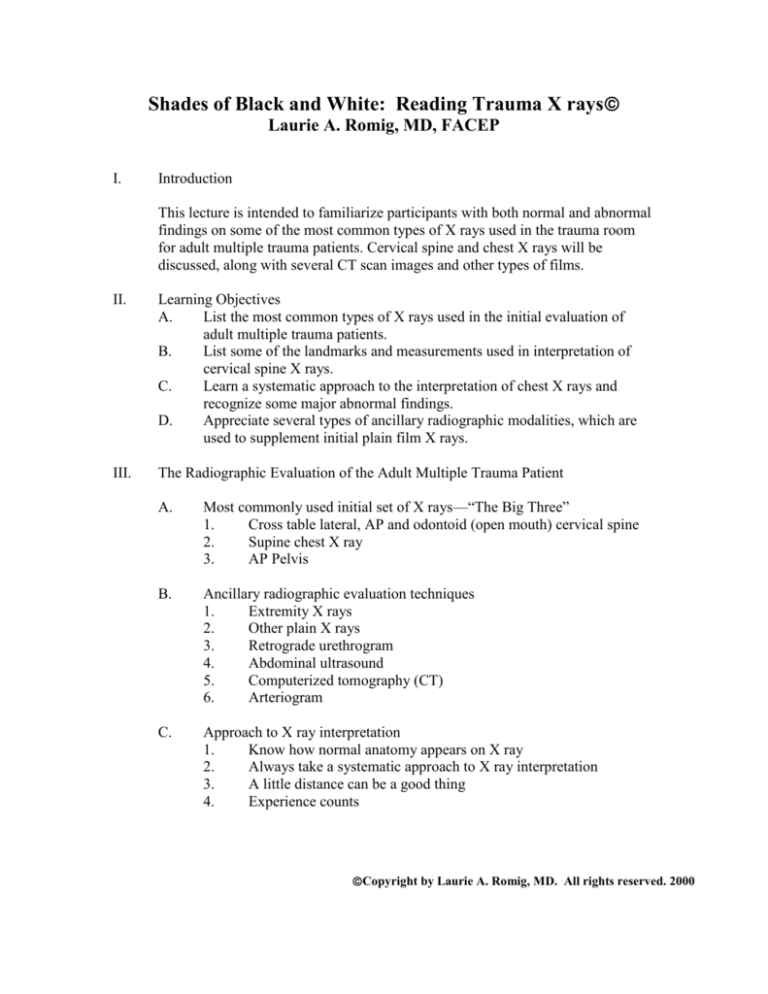
Shades of Black and White: Reading Trauma X rays
Laurie A. Romig, MD, FACEP
I.
Introduction
This lecture is intended to familiarize participants with both normal and abnormal
findings on some of the most common types of X rays used in the trauma room
for adult multiple trauma patients. Cervical spine and chest X rays will be
discussed, along with several CT scan images and other types of films.
II.
Learning Objectives
A.
List the most common types of X rays used in the initial evaluation of
adult multiple trauma patients.
B.
List some of the landmarks and measurements used in interpretation of
cervical spine X rays.
C.
Learn a systematic approach to the interpretation of chest X rays and
recognize some major abnormal findings.
D.
Appreciate several types of ancillary radiographic modalities, which are
used to supplement initial plain film X rays.
III.
The Radiographic Evaluation of the Adult Multiple Trauma Patient
A.
Most commonly used initial set of X rays—“The Big Three”
1.
Cross table lateral, AP and odontoid (open mouth) cervical spine
2.
Supine chest X ray
3.
AP Pelvis
B.
Ancillary radiographic evaluation techniques
1.
Extremity X rays
2.
Other plain X rays
3.
Retrograde urethrogram
4.
Abdominal ultrasound
5.
Computerized tomography (CT)
6.
Arteriogram
C.
Approach to X ray interpretation
1.
Know how normal anatomy appears on X ray
2.
Always take a systematic approach to X ray interpretation
3.
A little distance can be a good thing
4.
Experience counts
Copyright by Laurie A. Romig, MD. All rights reserved. 2000
Shades of Black and White: Reading Trauma X rays
Page 2
IV.
Cervical Spine X rays
A.
The lateral film
1.
Criteria for adequacy
a.
Is there anything obscured by jewelry or other opaque
objects?
b.
Is the X ray penetration appropriate?
c.
Must be able to see at least the top half of T1 at the lower
aspect and the occiput and palate at the superior aspect.
2.
Three curves to follow
a.
Anterior aspect of vertebral bodies
b.
Posterior aspect of vertebral bodies
c.
Spinolaminar line
d.
Abnormalities in the curves
i.
posterior malalignment is more significant than
anterior because of proximity of the spinal cord
ii.
spinal canal diameter is significantly narrowed if
< 14 mm
iii.
anterior subluxation is caused by facet dislocation
< 50% of vertebral body width = unilateral
dislocation
> 50% of vertebral body width = bilateral
dislocation
3.
Examine bones for symmetry
a.
May provide evidence of fracture
b.
Abnormal symmetry is often due to compression
i.
compression of > 40% of normal vertebral body
height usually indicates a burst fracture with
possibility of bone fragments in the spinal canal
ii.
anterior compression may cause a “teardrop”
shaped fracture
4.
Measurements
a.
Retropharyngeal/retrotracheal space
i.
7 mm at C2
ii.
< 50% of width of vertebral body at C4 and above
iii.
may be 100% width of vertebral body below C4
iv.
may be influenced by crying, yelling, etc.
v.
abnormal measurements may indicate soft tissue
swelling from obvious or occult fractures,
hematomas, or abscesses
b.
Anterior atlanto-dental interval
i.
3 mm in adult (5 mm in children)
ii.
> 3.5 mm indicates injury to transverse ligament
iii.
> 5 mm indicates complete transverse ligament
rupture and instability
Shades of Black and White: Reading Trauma X rays
Page 3
iv.
4
5.
V.
Rule of thirds
At the C1 level, the dens, spinal cord, and
empty space each occupy about a third of
the available space; therefore, there is
actually fairly considerable room for
swelling, dislocation, and movement.
Intervertebral disc spaces
a.
Decreased IVD space may indicate disc herniation
Relationship of occiput to atlas (C1)
a.
Distance between occiput and C1 should always be < 5 mm
b.
Increased distance may indicate atlanto-occipital
disassociation
B.
AP view
1.
Symmetry and size of vertebral bodies
2.
Alignment of spinous processes
3.
Smooth, rolling lateral edges
C.
Odontoid (open mouth) view
1.
Anatomy of C1-C2 (atlas and axis)
a.
Dens (C2)
b.
Lateral masses (C1)
c.
Rotation vs. fracture
d.
Watch out for those teeth!
D.
Abnormal cervical spine films
1.
Atlanto-occipital disassociation
2.
Dislocations
3.
C1 and C2 fractures
3.
Other cervical fractures
Chest X rays
A.
The systematic approach to chest X ray interpretation includes evaluation
of:
1.
Adequacy of the film
a.
Should be able to see both apices and both costophrenic
angles
b.
Appropriate penetration
2.
Bony structures
a.
Ribs
i.
fractures of the first and second ribs imply great
force and potential for underlying great vessel, lung,
and airway damage
b.
Sternum
c.
Clavicles
Shades of Black and White: Reading Trauma X rays
Page 4
d.
B.
Scapula
i.
fracture here may also be associated with great
force and underlying injuries
e.
Cervical and thoracic spine
3.
Mediastinum and major vessels
a.
Width of the mediastinum
i.
aortic injury
b.
Size of cardiac shadow
i.
hemopericardium
ii.
underlying medical problem
c.
Air in mediastinum/pericardium
d.
Trachea
i.
tracheal shift
4.
Lung fields
a.
Pneumothorax/tension pneumothorax
b.
Hemothorax
c.
Pulmonary contusion
d.
Atelectasis
e.
Infection
f.
Pulmonary edema
g.
Foreign bodies
5.
Soft tissue
a.
Subcutaneous emphysema
b.
Foreign bodies
6.
Diaphragm/abdomen
a.
Diaphragm position
b.
Position of gastric air bubble and/or NG/OG tube
i.
ruptured diaphragm
c.
Free air under diaphragm
i.
ruptured abdominal viscus organ
Abnormal chest X rays
1.
Bony abnormalities
2.
Mediastinal abnormalities
a.
Major vessel injury may be suggested by
i.
widened mediastinum
ii.
obliteration of the aortic knob
ii.
right mainstem bronchus shift up and to the right
iii.
NG tube deviates to the right
iv.
pleural cap present
3.
Pneumothoraces
4.
Hemothoraces
5.
Diaphragm injuries
6.
Pneumoperitoneum
Shades of Black and White: Reading Trauma X rays
Page 5
VI.
Internet Resources (Trauma and Radiology)
A.
http://brighamrad.harvard.edu/education/online/tcd/tcd.html
General radiology resource
B.
http://chorus.rad.mcw.edu/
Collaborative Hypertext of Radiology (Medical College of Wisconsin),
general radiology resource
C.
http://rmstewart.uthscsa.edu/
Univ. of Texas Health Sciences Center, trauma case studies with great
references
D.
http://www.swahs.nsw.gov.au/
Liverpool Hospital of Univ. of New South Wales, Australia, great trauma
case studies, trauma X rays, discussion list
E.
http://trauma.orhs.org/htmls/homepage2.html
Orlando Regional Medical Center, case studies with X rays
F.
http://www.trauma.org/
Fantastic general trauma and injury prevention resource, includes case
studies, extensive X rays, subscribe to Trauma email list
X.
Summary
A.
No matter what area of the body, the key to X ray interpretation lies in
knowledge of normal anatomy and its appearance on X ray and in a
systematic approach to interpretation. (What you don’t notice can hurt you
and the patient!)
B.
The most common initial X rays performed on adult multiple trauma
patients are the cervical spine, chest and pelvis plain film X rays.
C.
Very significant traumatic injuries can be diagnosed with these plain X
rays.
C.
Plain film abnormalities often lead to further study with other ancillary
radiographic modalities.










